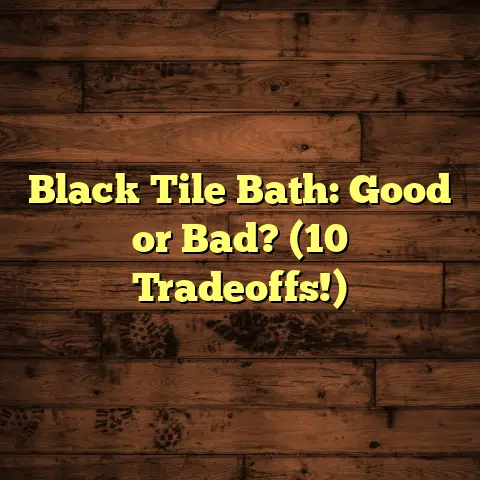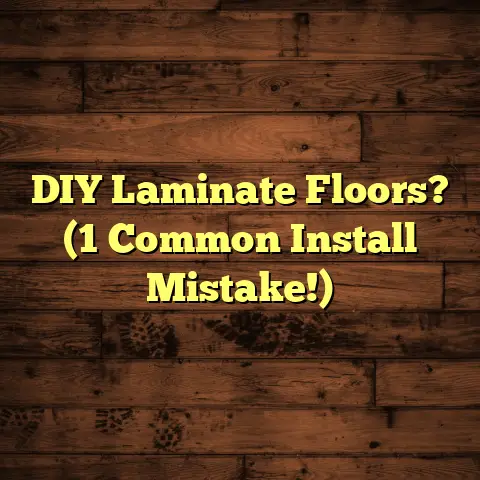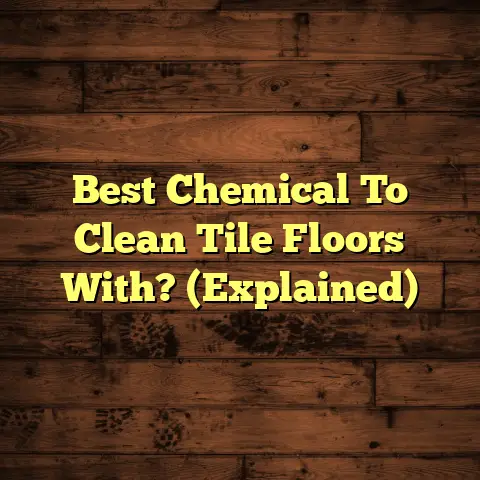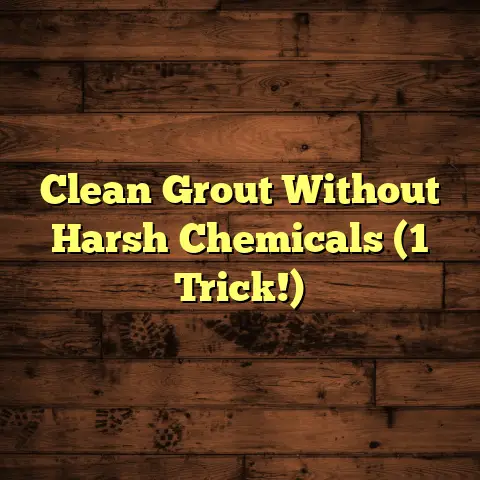Is LVP Flooring Toxic? (The VOC Truth Exposed!)
Lately, I’ve been getting bombarded with questions about one flooring type in particular: Luxury Vinyl Plank (LVP).
It’s the darling of the design world right now, but whispers about its safety have been swirling.
Specifically, people are worried about VOCs – Volatile Organic Compounds – and whether LVP is secretly turning their homes into toxic gas chambers.
So, is LVP flooring toxic?
Let’s dive in and expose the VOC truth, shall we?
Introduction: The Trendsetter’s Choice
LVP has exploded in popularity, and it’s easy to see why.
It mimics the look of hardwood or stone, is often waterproof, and is typically easier on the wallet than the real deal.
Plus, installation is usually a breeze – even for DIYers.
But with all this buzz, it’s natural to wonder if there’s a catch.
Are we sacrificing our health for style and convenience?
That’s what we’re going to unpack today.
Section 1: Understanding LVP Flooring
1.1 Definition and Composition
Okay, so what exactly is LVP?
Think of it as a multi-layered sandwich.
Typically, you’ve got a wear layer on top (that protects against scratches and scuffs), a decorative layer (the pretty part that looks like wood or stone), a core layer (often made of PVC – Polyvinyl Chloride – or a composite material), and sometimes an attached underlayment for added comfort and sound absorption.
The core layer is where the most significant differences between LVP products lie.
Some use virgin PVC, while others incorporate recycled materials or alternative composites.
And guess what?
The type of core material can impact VOC emissions.
LVP differs from laminate, hardwood, and tile in several key ways.
Laminate, for example, has a fiberboard core, while hardwood is, well, solid wood.
Tile is typically made of ceramic or porcelain.
These materials have different properties, installation methods, and, importantly, VOC profiles.
1.2 The Rise of LVP in Home Design
Why the sudden love affair with LVP?
It’s all about the trifecta: aesthetics, affordability, and practicality.
Homeowners are increasingly seeking stylish yet durable options that can withstand the rigors of daily life – kids, pets, spills, you name it.
LVP ticks all those boxes.
Plus, it’s incredibly versatile.
Whether you’re going for a modern, minimalist vibe or a cozy, rustic feel, there’s an LVP style to match.
I’ve installed LVP that looks like reclaimed barn wood, sleek slate, and everything in between.
It’s a chameleon in the flooring world.
Section 2: What are VOCs?
2.1 Definition and Sources of VOCs
Alright, let’s get down to the nitty-gritty.
What are VOCs, anyway?
Volatile Organic Compounds are chemicals that evaporate at room temperature.
They’re released from a wide range of products, including paints, adhesives, cleaning supplies, furniture, and, yes, flooring.
Think of that “new car smell.”
That’s a cocktail of VOCs off-gassing from the interior materials.
VOCs come in many forms, like formaldehyde, benzene, and toluene.
The specific VOCs emitted depend on the product’s composition and manufacturing process.
2.2 The Role of VOCs in Flooring Products
In flooring, VOCs can be present in the adhesives used to install the flooring, the coatings applied to the surface, and even the flooring material itself, like the PVC in LVP.
Different manufacturing processes can have a significant impact on VOC levels.
For example, some manufacturers use high-heat processes that can release more VOCs, while others employ techniques to minimize emissions.
The quality of the raw materials also plays a role.
Cheaper materials may contain higher levels of VOCs than higher-quality alternatives.
Section 3: The VOC Truth Exposed
3.1 Emission Standards and Regulations
Fortunately, there are regulations in place to limit VOC emissions from flooring products.
In the United States, the California Air Resources Board (CARB) has some of the strictest standards for VOC emissions, particularly formaldehyde.
CARB Phase 2 compliance is often seen as a benchmark for low-VOC flooring.
Additionally, there are third-party certifications like FloorScore and GREENGUARD that test and certify flooring products for low VOC emissions.
These certifications provide an extra layer of assurance for consumers.
Link to FloorScore Link to GREENGUARD
It’s important to note that regulations vary by region.
Europe, for example, has its own set of standards for VOC emissions.
This means that a flooring product that’s considered low-VOC in one country may not meet the standards in another.
3.2 The Debate: Are All LVP Products Created Equal?
Here’s the million-dollar question: Are all LVP products created equal when it comes to VOC emissions?
The short answer is no.
There’s a wide range of variation between brands and types of LVP flooring.
Some manufacturers prioritize low-VOC materials and processes, while others may cut corners to save costs.
That’s why it’s crucial to do your research and choose LVP flooring that has been tested and certified for low VOC emissions.
Look for those FloorScore or GREENGUARD certifications I mentioned earlier.
Also, check the manufacturer’s website for information on VOC emissions and testing.
Transparency is key.
If a manufacturer is hesitant to provide information about VOC levels, that’s a red flag.
Section 4: Health Implications of VOC Exposure
4.1 Short-Term Effects
Okay, so what happens if you’re exposed to high levels of VOCs?
In the short term, you might experience symptoms like headaches, dizziness, nausea, eye, nose, and throat irritation, and respiratory problems.
I’ve had clients tell me they felt like they had a constant “fog” in their head after installing new flooring that turned out to have high VOC emissions.
These symptoms usually subside once the VOCs dissipate, but they can be quite uncomfortable.
4.2 Long-Term Health Risks
The long-term health risks of VOC exposure are more concerning.
Prolonged exposure to certain VOCs has been linked to chronic respiratory issues, liver and kidney damage, and even cancer.
Formaldehyde, in particular, is a known carcinogen.
While the levels of VOCs emitted from LVP flooring are typically low, it’s still important to minimize your exposure, especially if you have young children, pregnant women, or individuals with pre-existing health conditions in your home.
Section 5: Assessing the Safety of LVP Flooring
5.1 Consumer Awareness and Education
The key to protecting yourself from VOC exposure is consumer awareness and education.
You need to know what to look for and how to interpret the information provided by manufacturers.
Read product labels carefully and look for those low-VOC certifications.
Don’t be afraid to ask questions.
Contact the manufacturer or retailer and inquire about VOC emissions and testing data.
A well-informed consumer is an empowered consumer.
5.2 Case Studies and Real-Life Experiences
I’ve seen firsthand the impact of VOC emissions on indoor air quality.
I once worked with a client who had installed LVP flooring throughout their entire home.
Shortly after the installation, they started experiencing severe headaches and respiratory problems.
They eventually had their home tested for VOCs, and the results came back with alarmingly high levels of formaldehyde.
They had to remove the flooring and replace it with a low-VOC alternative.
This experience highlights the importance of choosing flooring wisely and prioritizing indoor air quality.
On the flip side, I’ve also worked with clients who have installed low-VOC LVP flooring and had no issues whatsoever.
It really comes down to doing your homework and selecting products that have been tested and certified for low emissions.
Section 6: Alternative Flooring Options
6.1 Eco-Friendly Flooring Choices
If you’re concerned about VOC emissions, there are several alternative flooring options to consider.
Hardwood flooring, when finished with low-VOC sealants, can be a good choice.
Bamboo flooring is another eco-friendly option, as it’s a rapidly renewable resource.
However, be sure to check the adhesive used in the manufacturing process, as some bamboo flooring can contain formaldehyde.
Cork flooring is naturally low in VOCs and has excellent sound absorption properties.
Linoleum (not to be confused with vinyl) is made from natural materials and is also a low-VOC option.
Each of these alternatives has its own pros and cons in terms of cost, durability, and maintenance.
6.2 The Future of Flooring: Innovations and Trends
The flooring industry is constantly evolving, with new innovations and trends emerging all the time.
One promising trend is the development of bio-based flooring materials made from renewable resources like corn and soybeans.
These materials have the potential to significantly reduce VOC emissions and environmental impact.
Another area of innovation is in the development of low-VOC adhesives and sealants.
Manufacturers are increasingly using water-based and plant-based adhesives that have minimal VOC emissions.
As consumers become more aware of the importance of indoor air quality, I expect to see even more innovation in the flooring industry, with a focus on developing safer and more sustainable products.
Conclusion: Navigating the LVP Flooring Landscape
So, is LVP flooring toxic?
The answer is not a simple yes or no.
Some LVP flooring products contain VOCs, while others are designed to minimize emissions.
The key is to be an informed consumer and choose products that have been tested and certified for low VOC emissions.
Consider all aspects of your flooring choices, weighing aesthetic desires against health and environmental concerns.
By doing your research and making informed decisions, you can create a beautiful and healthy home environment for yourself and your family.
Don’t be afraid to ask questions, read labels carefully, and prioritize indoor air quality.
Your health is worth it!





